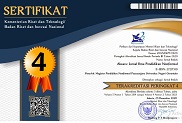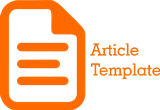An Evaluation of ‘Get Smart’ English Language Textbook from the Perspectives of English Teachers
Abstract
This study aimed to evaluate Get Smart year three ELT textbook. A mixed method
design of quantitative questionnaires and qualitative interviews was used. Thirtyeight ESL lecturers from primary schools in Malaysia have been studied for their perspectives on Get Smart textbook. The quantitative questionnaires were analyzed for descriptive statistics and interviews were analyzed thematically. The findings from both questionnaire and interviews showed that Get Smart is one of the most useful books for ELT in primary schools in Malaysia. However, there were some
parts which need to be improved such as the lack of creativity in illustrations,
challenging vocabulary, the social and cultural mismatch, use of difficult words in
grammar explanations, lack of sentence and paragraph structures in the writing part. These findings show that Get Smart textbook is suitable but still there are some parts that need improvement.
Keywords
Full Text:
PDFReferences
AbdelWahab, M. M. (2013). Developing an English language textbook evaluative
checklist. IOSR Journal of Research & Method in Education, 1(3), 55-70.
Akef, K., & Moosavi, Z. (2014). Iranian EFL teachers' and students' textbook
evaluation. The Iranian EFL Journal, 10(6), 1.
Al-Hajailan, T. (2003). Teaching English in Saudi Arabia. Riyadh: Aldar Alsawtia
for Publishing and Distribution.
Alamri, A. A. M. (2008). An evaluation of the sixth grade English language
textbook for Saudi boys' schools. Unpublished MA thesis, Riyath, Saudi
Arabia.
Angell, J., DuBravac, S., & Gonglewski, M. (2008). Thinking globally, acting
locally: Selecting textbooks for collegeâ€level language programs. Foreign
Language Annals, 41(3), 562-573.
Ansary, H., & Babaii, E. (2002). Universal characteristics of EFL/ESL textbooks:
A step towards systematic textbook evaluation. The Internet TESL Journal,
(2), 1-9.
Bryman, A., Becker, S., & Sempik, J. (2008). Quality criteria for quantitative,
qualitative and mixed methods research: A view from social policy.
International Journal of Social Research Methodology, 11(4), 261-276.
Chegeni, N., Kamali, B., Noroozi, A., & Chegeni, N. (2016). General English
Textbook Evaluation: A Closer Look at “Four Cornersâ€. Theory and
practice in language studies, 6(12), 2325-2330.
Cohen, L., Manion, L., Morrison, K., & Morrison, R. (2007). Research methods in
education†Routledge. In: USA and Canada.
Demir, Y., & Ertas, A. (2014). A suggested eclectic checklist for ELT coursebook
evaluation. Reading, 14(2).
Dörnyei, Z., & Taguchi, T. (2009). Questionnaires in second language research:
Construction, administration, and processing: Routledge.
Ereksoussy, M. (1993). Evaluating the English language textbook studied in the
first year at girls' intermediate schools in Saudi Arabia. Unpublished MA
dissertation, King Saud University, Riyadh.
Harmon, J. M., Wood, K. D., & Kiser, K. (2009). Promoting vocabulary learning
with the interactive word wall. Middle School Journal, 40(3), 58-63.
Hutchinson, T., & Waters, A. (1987). English for specific purposes: Cambridge
university press.
King, N., Cassell, C., & Symon, G. (2004). Using templates in the thematic analysis
of text. Essential guide to qualitative methods in organizational research,
, 256-270.
Malterud, K. (2001). Qualitative research: standards, challenges, and guidelines.
The lancet, 358(9280), 483-488.
McGrath, I. (2002). Materials evaluation and design for language teaching:
Edinburgh University Press.
Miles, M. B., Huberman, A. M., Huberman, M. A., & Huberman, M. (1994).
Qualitative data analysis: An expanded sourcebook: sage.
Mukundan, J., & Kalajahi, S. A. R. (2013). Evaluation of Malaysian English
language teaching textbooks. International Journal of Education and
Literacy Studies, 1(1), 38-46.
Nation, I. S. (2001). Learning vocabulary in another language: Ernst Klett
Sprachen.
Nimehchisalem, V., & Mukundan, J. (2015). Refinement of the English Language
Teaching Textbook Evaluation Checklist. Pertanika Journal of Social
Sciences & Humanities, 23(4).
Radhakrishna, R. B. (2007). Tips for developing and testing
questionnaires/instruments. Journal of extension, 45(1), 1-4.
Richards Jack, C., & Rodgers, T. S. (2001). Approaches and Methods in Language
Teaching. Cambridge UK.
Sandelowski, M. (1995). Qualitative analysis: What it is and how to begin.
Research in nursing & health, 18(4), 371-375.
Sarem, S. N., Hamidi, H., & Mahmoudie, R. (2013). A critical look at textbook
evaluation: A case study of evaluating an ESP course-book: English for
international tourism. International Research Journal of Applied and Basic
Sciences, 4(2), 372-380.
Sheldon, L. E. (1988). Evaluating ELT textbooks and materials. ELT journal, 42(4),
-246.
Skarupova, K., & Blinka, L. (2013). Systematic review of online gaming addiction
measures. Paper presented at the JOURNAL OF BEHAVIORAL
ADDICTIONS.
Soleimani, H., & Dabbaghi, A. (2012). Textbook evaluation: A reflection on the
New Interchange Series. International Journal of Research Studies in
Language Learning, 1(2), 19-32.
Thein, N. (2006). Evaluating the suitability and effectiveness of three English
coursebooks at Myanmar Institute of Technology. Unpublished MA thesis,
University of Thailand. Thailand.
Tomlison, C. (2001). How to differentiate instruction in mixed classrooms. In:
Alexandria, VA: ASCD.
Zohrabi, M. (2011). An Evaluation of Classroom Activities and Exercises in ELT
Classroom for General Purposes Course. English Language Teaching, 4(1), 141-151.
DOI: http://dx.doi.org/10.37905/aksara.7.2.727-746.2021
Refbacks
- There are currently no refbacks.
Copyright (c) 2021 Aksara: Jurnal Ilmu Pendidikan Nonformal

This work is licensed under a Creative Commons Attribution-ShareAlike 4.0 International License.
Publisher:
Magister Pendidikan Nonformal Pascasarjana Universitas Negeri Gorontalo
Jl. Soedirman No. 06 Gorontalo 96128 e-mail: jurnalaksara@ung.ac.id
http://ejurnal.pps.ung.ac.id







